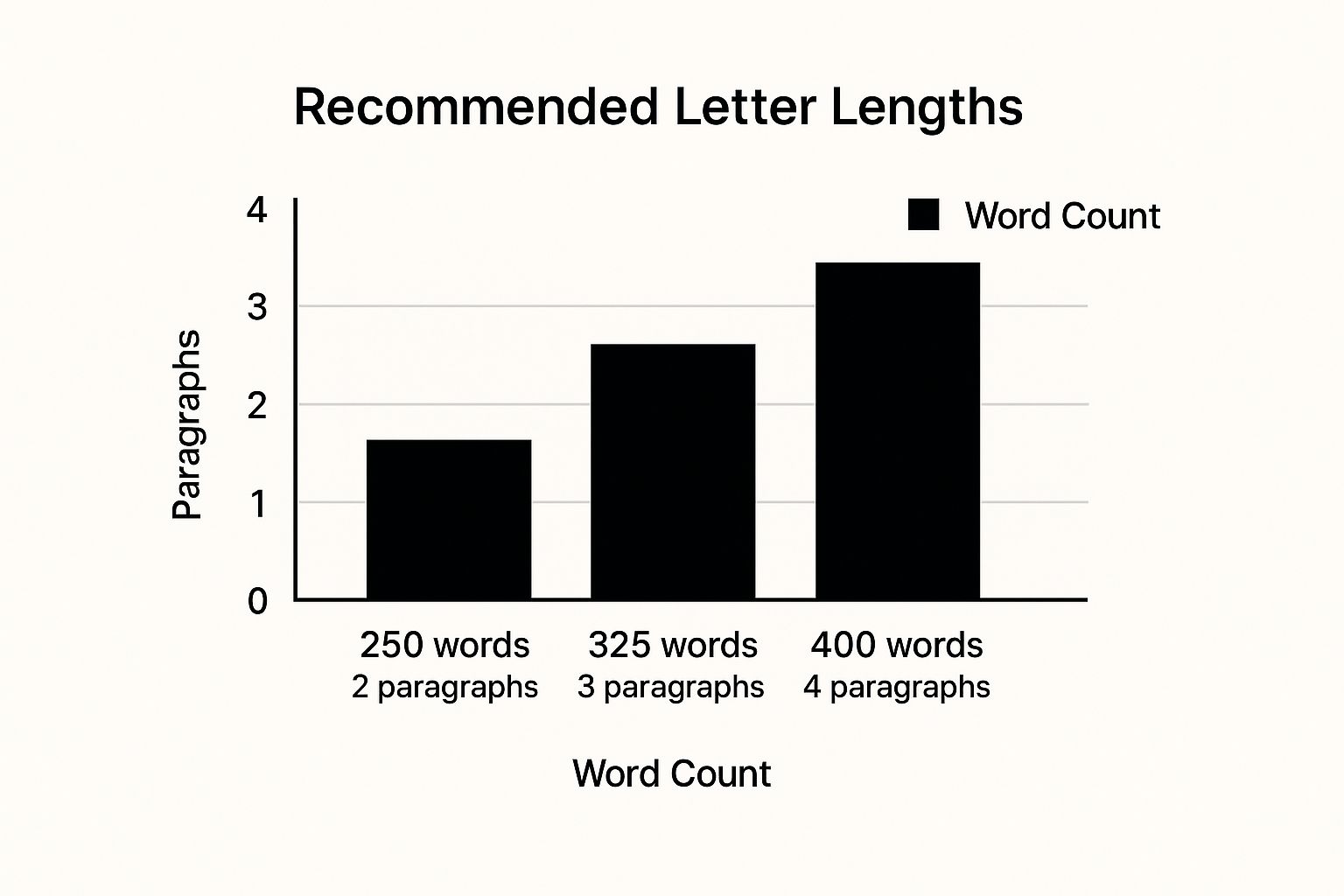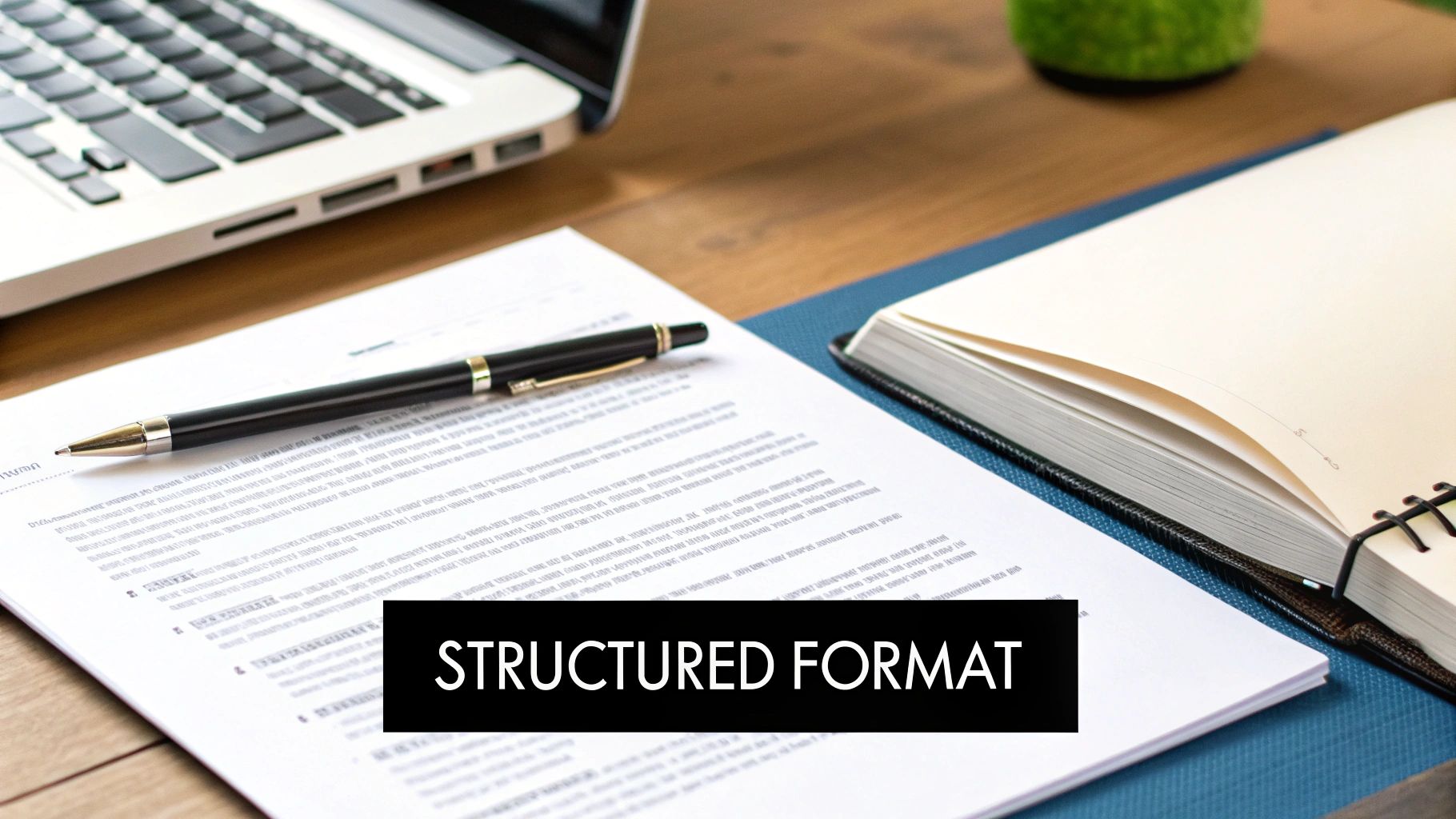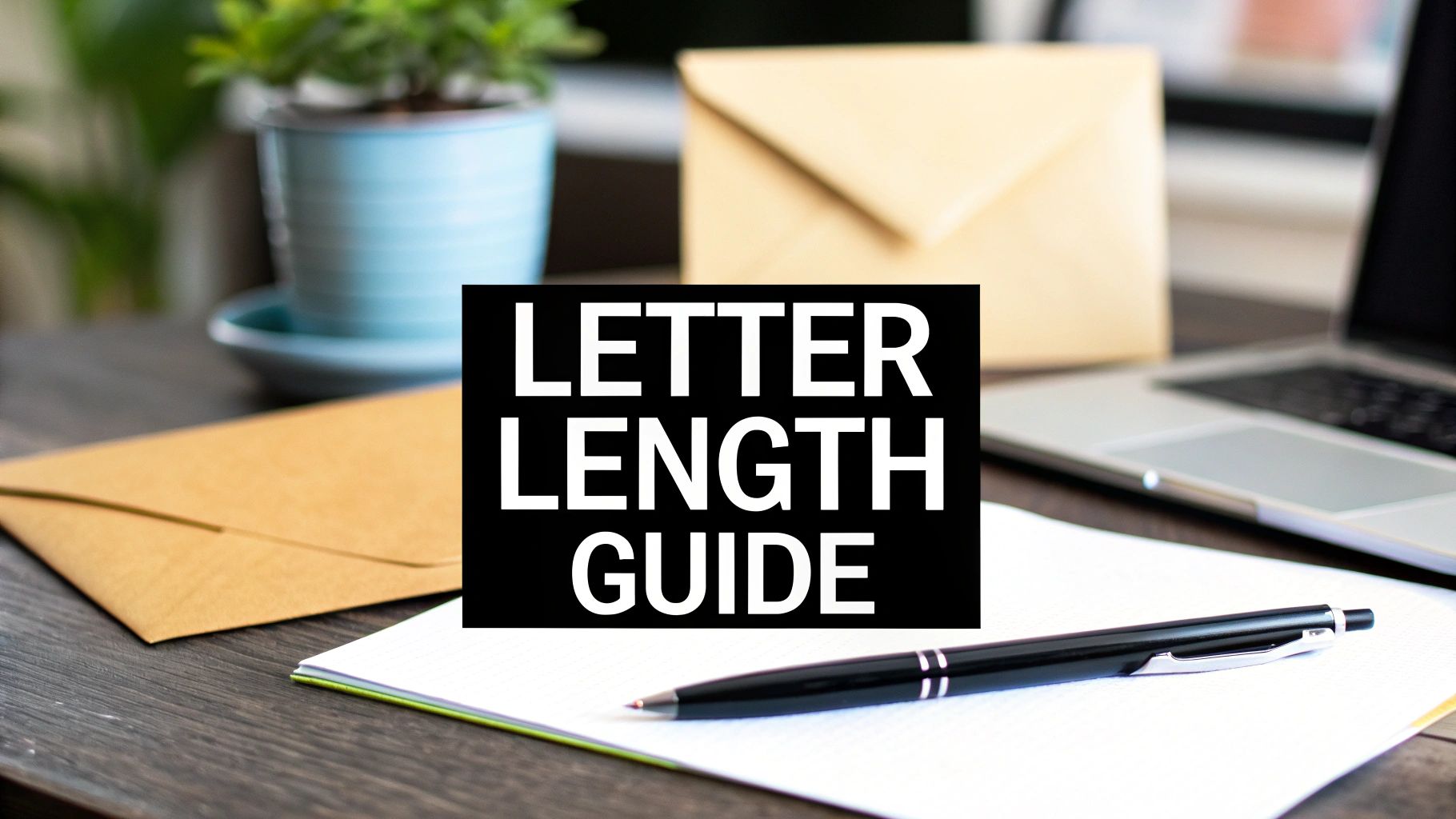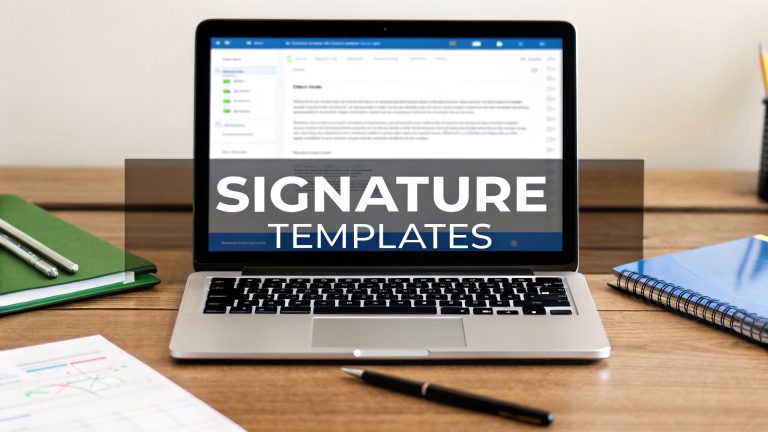When you're writing a letter of interest, the magic number is somewhere between 250 and 400 words. Think of it this way: it needs to fit comfortably on a single page, without you having to shrink the font to an unreadable size. This is your professional sweet spot.
It's long enough to prove you've done your homework and have something real to offer, but short enough to respect that the person reading it is incredibly busy. You're aiming for a compelling trailer for your career, not the full-length feature film.
Finding the Perfect Balance
The real challenge is hitting that sweet spot between being brief and being memorable. One of the quickest ways to get your letter tossed aside is by letting it spill onto a second page. It sends a message that you can't edit yourself or don't value the reader's time.
The key is to deliver a punchy, powerful message without drowning them in details.
This visual guide breaks down how your paragraph structure naturally helps you stay within the right word count.

As you can see, if you stick to a solid three or four-paragraph structure, you’ll naturally land right in that ideal 250-400 word zone.
Why Less Is More
You don't just have to take my word for it. Hiring data consistently shows that shorter, more focused letters get better results. A massive review of over half a million cover letters revealed the median length was just 224 words.
Even more telling? Only about a quarter of all applicants sent letters longer than 394 words. If you're curious about the data, you can check out the full analysis on cover letter length.
For a quick reference, here's a simple breakdown of what to aim for.
Letter of Interest Length At a Glance
This table sums up the essential components and their ideal lengths, making it easy to see how to structure your letter for maximum impact.
| Component | Recommended Length | Why It Matters |
|---|---|---|
| Introduction | 3-4 sentences | Grabs attention immediately and states your purpose clearly. |
| Body Paragraphs | 2-3 paragraphs (4-6 sentences each) | Connects your specific skills to the company's needs without rambling. |
| Conclusion | 2-3 sentences | Ends confidently with a clear call to action (e.g., a meeting). |
| Total Word Count | 250-400 words | Respects the reader's time and forces you to be focused. |
| Total Page Count | 1 page | A non-negotiable industry standard; anything more is too long. |
Ultimately, a well-written letter proves you can communicate effectively and prioritize information—a skill every employer values.
Your letter isn't supposed to be your life story. Its only job is to pique their interest enough to start a conversation. You don't need to list every single job you've had; just share the most impressive highlights that show you understand what they do and how you can help. For more tips on making every word count, our guide to professional letter writing is a great resource.
Why a Shorter Letter Makes a Stronger Impression
Let's be real: a hiring manager's inbox is a crowded place. When your letter of interest lands there, you’ve got just a handful of seconds to make them stop scrolling and pay attention. This isn't a guess; it's the simple truth of today's job market.
Think of your letter like a billboard on a busy highway. It needs to get a powerful message across in a split second. A long, rambling letter is like a billboard crammed with tiny, unreadable text—people just fly right by. A sharp, concise letter, on the other hand, delivers the punchline immediately.

Respecting the Recruiter's Time
Keeping it short isn't about being lazy. It’s a smart move that shows you have key soft skills. A focused message proves you can communicate with clarity and, more importantly, that you respect the reader’s time. Every employer wants that.
This shows you get the reality of "recruiter fatigue." A staggering 76% of talent professionals report feeling swamped by the sheer volume of applications they receive. Your brief, to-the-point letter is a breath of fresh air. It demonstrates you know how to cut through the noise, a principle that also lies at the heart of strong client communication best practices.
There’s a huge gap between how much people write and how much recruiters actually read. Eye-tracking studies reveal a recruiter typically spends just 12-15 seconds on a letter of interest. That’s it. This tiny window is precisely why the sweet spot is 150-250 words, spread across three or four short paragraphs. Go longer, and you're literally writing for no one.
Key Takeaway: A concise letter doesn't just list your skills. It shows them. It proves you're a professional, a clear communicator, and someone who respects the hiring manager's time—making a far better first impression.
Structuring Your Letter for Maximum Impact
Okay, so we've established the ideal length for a letter of interest. Now, let's get into the practical side of things: how to actually structure it. A solid framework is what keeps you within that sweet spot of 250-400 words and makes every single sentence count.
Think of your letter as a short, compelling story with a beginning, a middle, and an end. Each part has a distinct job, guiding the reader from a quick glance to a genuine "we should talk to this person."

Part 1: The Hook
Your first paragraph is everything. It’s your handshake, your first impression. You have to grab their attention right away and prove your interest is in their company, not just any company with an open door.
- Word Count Goal: Around 50-75 words.
- Purpose: Kick things off by expressing your genuine enthusiasm for the organization. Briefly introduce who you are professionally and mention something specific about them that caught your eye—a recent project, a company value you admire, or a big achievement.
Part 2: The Connection
This is the heart of your letter. It's where you stop talking about yourself in a vacuum and start connecting your skills directly to what they do. Don't just list your accomplishments; show them how you can be an asset.
- Word Count Goal: Roughly 150-250 words.
- Purpose: Draw a clear line between your top 2-3 skills and the company's goals. Use real-world examples. Instead of saying you're a "great collaborator," talk about a project where your teamwork directly led to a positive outcome. For more inspiration on how to frame this, check out these cover letter structure examples.
Pro Tip: Using bullet points here is a game-changer. It breaks up the text and makes your key qualifications pop. A hiring manager skimming through applications is far more likely to absorb bulleted information than a dense paragraph.
Part 3: The Call to Action
Time to stick the landing. Your final paragraph needs to be confident, polite, and proactive. You’re not demanding a job, but you are clearly proposing the next step.
- Word Count Goal: Keep it brief, under 50 words.
- Purpose: Thank the reader for their time and consideration. Then, clearly state your eagerness to discuss how your background could help their team succeed. End by suggesting a brief chat or meeting.
Adjusting Your Letter Length for Different Industries
While that 250-400 word count is a great rule of thumb, it's not a universal law. The best length for your letter of interest really depends on the industry you're trying to break into. It’s a bit like a dress code—what works for a creative ad agency won't fly at a buttoned-up law firm.
You need to match your letter's length and tone to the culture of the field. For instance, creative industries like marketing or design are often more open to a letter with personality. You can probably lean closer to the 400-word mark if you have a great story to tell about a campaign you managed. Just make sure every word you add is pulling its weight and showing off your unique way of thinking.
Tailoring Your Approach by Sector
On the other hand, some of the more traditional industries value a direct, no-nonsense approach. In these fields, being concise isn't just a good idea; it's a way of showing you're a professional who respects their time.
-
Tech and Academia: Here, you might need a little more room to briefly touch on complex projects or research. It's okay to use the full 400 words if you need them for essential context, but steer clear of getting lost in the technical weeds.
-
Finance and Law: These sectors are all about efficiency. Stick to the lower end of the range, somewhere around 250-300 words. Your goal is to get straight to the point, lay out your qualifications, and move on.
A global analysis of successful applications shows that while some markets are more tolerant of longer letters, brevity is a universal advantage. The vast majority of successful candidates keep their letters concise to make an immediate impact.
No matter the industry, remember that shorter is almost always a safer bet. While some US hiring managers might say they're fine with letters up to 400 words, the data tells a different story. A whopping 75% of cover letters from people who actually got the job were 250 words or less.
If you're curious, you can dig into more data-driven insights about application lengths on myperfectresume.com. The trend is clear: making your case quickly is a skill that gets you noticed.
Common Mistakes That Make Your Letter Too Long
Knowing you should keep your letter of interest short is one thing. Actually doing it is another. The number one reason these letters balloon in size is a loss of focus. What starts as a sharp, targeted pitch slowly turns into a long-winded story of your entire career.
To keep your letter lean and powerful, you have to sidestep the common traps that add unnecessary fluff. A hiring manager doesn't want a play-by-play of every job you've ever held. They need to see, quickly, how your best skills can solve their problems right now.

Mistake 1: Regurgitating Your Resume
This is the biggest pitfall by far—simply turning your resume's bullet points into sentences. Your letter of interest and your resume have two completely different jobs. Think of your resume as the full, detailed record, while your letter is the compelling trailer that makes someone want to see the full movie.
Instead of just listing facts they can find elsewhere, use the letter to tell a quick, engaging story that connects your biggest wins to what the company cares about.
Mistake 2: Using Vague Buzzwords
Words like "synergistic," "results-oriented," or "dynamic" are just filler. They might sound professional, but they don't actually communicate anything meaningful without proof. A letter packed with these terms ends up feeling bloated and weak.
Before: "I am a results-oriented professional with a proven track record of leveraging dynamic strategies to achieve synergistic outcomes."
After: "In my last role, I led a project that increased team efficiency by 25% by implementing a new software workflow."
See the difference? The "after" example is not only shorter but packs a much bigger punch. It gives the reader a concrete achievement to hang onto. Using real numbers and specific outcomes is a cornerstone of great letter writing etiquette and one of the top do's and don'ts for leaving a memorable impression.
Mistake 3: Over-Explaining Your Career Path
There's no need to justify every job change or walk the reader through your career timeline. The only thing that matters here are the experiences directly relevant to the company you're reaching out to. Give them the "greatest hits" of your career, not the entire box set.
A good rule of thumb is to:
- Stick to your top 2-3 qualifications.
- Connect each one directly to the company's needs or mission.
- Cut any detail that doesn't serve that specific goal.
Steering clear of these common missteps will help you stay within the ideal word count naturally. Your final letter will be sharper, more impactful, and—most importantly—it will actually get read.
Got More Questions About Length? Let's Clear Things Up.
Even with the best advice, a few nagging questions can pop up when you're trying to get the length of your letter just right. Let's walk through some common scenarios so you can feel totally confident before sending it off.
Is It Ever Okay to Go Over One Page?
Honestly? Almost never. Spilling onto a second page is one of the fastest ways to get your letter tossed aside. To a busy hiring manager, it signals that you can't be concise or don't respect their time.
Think of the one-page rule as a helpful constraint. It forces you to be sharp, focused, and compelling. The goal isn't to list every single thing you've ever done; it's to spark enough curiosity to land a real conversation.
Does the Length Change If It's an Email?
Absolutely. For an email, you need to be even more brief. If you're putting your letter directly into the body of an email, aim for a maximum of 150-250 words. It's the ultra-condensed version of your pitch.
An email inquiry is a quick, powerful elevator pitch. It has to be scannable in 15 seconds or less, which makes brevity your best friend. Get straight to the point, show your value, and end with a clear next step.
But What If I Have Way Too Much to Say?
This is a classic problem, especially for those with years of rich experience. It can feel like an impossible task to fit a whole career into just a few paragraphs. The solution is a simple mindset shift.
Instead of trying to cram everything in, zero in on the top 2-3 qualifications that matter most to this specific company. Ask yourself a couple of pointed questions:
- Which of my wins directly connect to this company's goals or recent work?
- What's the unique value I offer that they won't find anywhere else?
This isn’t about downplaying your career. It’s about being a strategic storyteller—hand-picking your best highlights to make the strongest first impression possible.
Feeling stuck trying to get it all down on paper? The AI Letter Generator can help you write a powerful, perfectly-sized letter in just a few seconds. Our tool makes sure you hit the ideal word count every time, so you can stand out without the stress. Try it for free at lettergenerator.co and see how simple it can be.



